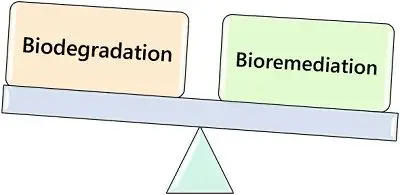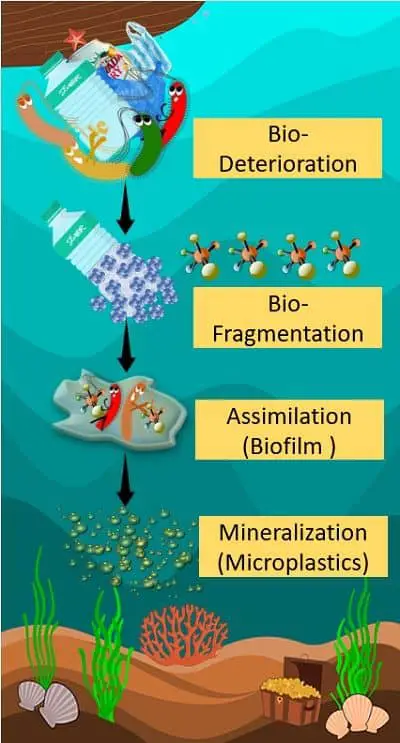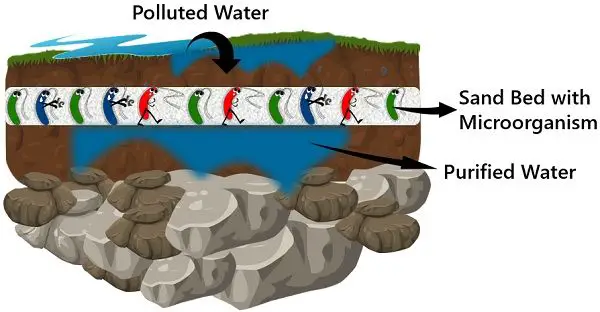Both Bioremediation and Biodegradation are microorganism governed processes. They deal with the hazardous chemicals prevailing in our environment. But both of them differ widely based on their functioning and biotreatment potential.
Biodegradation is a self occurring process. This process biotransforms the toxins into their simpler non-toxic form by using microorganisms. It is a slow process that doesn’t require any human intervention.
Whereas Bioremediation is a human-driven process to remove and reduce environmental toxins. It works by exploiting the ability of microbes to digest and consume the toxin through their metabolic processes. It is a faster method requiring technical experts to carry out the experiment.
In this section, we will discuss key differences between Biodegradation and Bioremediation.
Content: Cytokinesis Vs Karyokinesis
Comparison Chart
| Basis of Comparison | Biodegradation | Bioremediation |
|---|---|---|
| Meaning | The degradation process biologically transforms the complex organic debris into simpler compounds by using live microorganisms. | It is a human-induced remedial method that uses microbial fauna to eliminate and reduce hazardous environmental contaminants. |
| Principle | It is dependent on the microbes' metabolic operations progressively converting complex hazardous compounds to simpler non-toxic ones. | It works on the idea of toxic chemicals being removed from the environment by allowing microorganisms to absorb and break down the contaminants into simpler, non-harmful materials. |
| Need of Human Intervention | Any human assistance is not necessary. | It needs proper monitoring and assistance from an expertized person. |
| Time required | It is a slow process that requires ample time for the complete transformation process. | It is comparatively a faster process. |
| Type of Process | Self-occurring natural phenomenon | An engineered process that human artificially induces |
| Technical requirement | Doesn't demand any technical instrumentation or processing. | It requires skilled experts and a technical setup for designing and executing the process. |
| Effects | Mostly beneficial but can turn into a harmful process under certain circumstances. | It is always a beneficiary process |
What is Biodegradation?
Biodegradation is a simple biological decay process that occurs due to microbial action. This phenomenon recycles the toxic organic debris in non-harmful compounds. The microorganism decomposes the contaminants to replenish the environment with ample nutrients again. So, we can say that it is a natural waste management system.
Microbes are the chief recyclers as they control all the environmental biogeochemical cycles. They break down the pollutants into simple substances through their metabolic processes. The end products are non-toxic compounds like carbon dioxide and water.
Microbial fauna, including bacteria and fungus, play a significant role in Biodegradation.
Factors Affecting Biodegradation
The following factors impact the process of Biodegradation:
- Chemical composition and nature of the toxin
- Degradation potential of the microorganism
- Temperature and pH of the degradation process
- Redox potential,
- Nutrient delivery
- Proper oxygen supplying
Among the above factors, the chemical nature of the compound determines the biodegradation process.
- The compounds having simpler aliphatic chains are easily degradable.
- Compounds having cyclic aromatic rings and branched chains are difficult to degrade biologically.
- Water-soluble toxins are easy to tackle as they begin to decompose in the presence of water.
- The molecular configuration of the aromatic compounds also affects Biodegradation. The level of degradation decreases in the following manner:
Ortho > Para > Meta.
- Halogenated compounds are more difficult to degrade. This is because the halogen in the aromatic ring hinders the process.
Enzyme systems for Biodegradation
Microbes have certain enzyme systems. The enzymes work independently to meet a common goal. Similarly, in the case of contaminants degradation, several approaches exist.
Desired gene coding for a particular degradative enzyme may be present in chromosomal DNA or in the plasmid. In some cases, both chromosomal and plasmid DNA participate in the biodegradation mechanism.
Mechanism of Biodegradation
The biodegradation mechanism occurs in four phases:
1. Biodeterioration
The surface level deterioration transforms the physical and mechanical properties of the contaminant. Here, the material comes in contact with the environmental factors. This causes the weakening of the material. This process eases the other process for microbial consumption.
2. Biofragmentation
This lytic process cleaves the polymer by breaking down the chemical bond. Long and branched polymers break down to produce several oligomers and monomers.
3. Assimilation
The microbes assimilate the resultant oligomers and monomers of fragmentation. Some molecules easily penetrate inside the cell via the cell membrane. While some need transportation by membrane carriers.
As these molecules enter inside the microbial cells metabolic reactions produce energy (ATP). These reactions produce simple non-toxic compounds as by-products.
4. Mineralization
This is not a mandatory process that always occurs. Under certain circumstances, the organic by-products get converted into inorganic matter. This process is mineralization.
Advantages of Biodegradation
- It is a natural process. Here, the biological microbial fauna treats the earth by removing the polluting contaminants.
- It requires human assistance or monitoring.
- Causes minimal destruction and disturbance to the surrounding environments.
- Permanently eradicate the problematic waste.
- It can easily be paired with any other method to upgrade the process.
Limitations of Biodegradation
- Certain chemicals are recalcitrant. They do not undergo the biodegradation process naturally. Thus, they remain in the environment for a very long period of time. These are recalcitrant xenobiotics.
- The process might develop unknown by-products.
- It is a slow process that varies with
a. Level of toxicity
b. Degradation potential of microbes.
What is Bioremediation?
Bioremediation is a division of biotechnology. It refers to the human-induced microbial degradation of the toxic compound. It employs the use of microbial fauna to clean the polluted zones.
We know that the microbes are the invisible workforce that is fighting pollution. But this war between pollution and microbe is very slowly executing. Due to this, Bioremediation becomes a problem-solving approach here.
Bioremediation enhances the average growth of microbial fauna. capable of biotransformation at the pollution site. This deliberate growth transforms the toxins into harmless products. It requires proper human assistance and requires accurate monitoring.
Types of Bioremediation
Two methods attain the environmental clean by the Biodegradation:
a. In-situ Bioremediation
It is a direct approach for the removal of the toxins like xenobiotics directly from the site of pollution. For this process, the extra nutrients are supplied at the site. This increases the growth of microbial fauna.
At the time of growth, the microbes consume pollutants as their food. They have a certain metabolic potential to digest them. And also convert harmful compounds into simple non-harmful molecules.
This process relies on two primary factors:
- Adequate nutrient supply
- Proper microbial growth
Bioremediation is highly effective in curbing hazardous oil spills, xenobiotics, chemical pesticides etc.
We can further divide it into two types:
- Intrinsic Bioremediation
This process depends on the inherent decomposing potential of the microbe. To attain the best results various microbes are analysed in laboratories. - Engineered In-situ Bioremediation
Sometimes microbes’ inherent ability is insufficient to curb the stack of pollutants around us. Thus, by using modern genetic engineering tools, microbes are induced to digest the chemical at a higher rate.
They are introduced at the pollution site with adequate nutrient supply for Bioremediation.
Advantages of in situ bioremediation
- Spots of Bioremediation are nominally disturbed.
- Economic process.
- Minimal contact to the site of pollution.
Disadvantages of in situ bioremediation
- The degradation potential of the microbes may vary from time to time.
- Time-consuming.
- Polluted sites having heavy microbial growth are at severe risk of exposure to the environment.
b. Ex-situ Bioremediation
Here, we collect the pollutants from the pollution site into specially designed place. After that, we treat them with specified microbes. It is an advanced process that has provided successful results. This process overcomes the problems related to in situ remediations.
Advantages of Ex-situ remediation
- Time-efficient
- We can improvise the process by increasing the nutrient supply and microbes as per the requirement.
- We can monitor and control the process with more accuracy.
Disadvantages of Ex-situ Bioremediation
- Expensive
- Pollution sites are very much disrupted.
- The disposal of the remaining debris is a big problem.
Types of Reaction in Bioremediation
The bioremediation process involves three remedial reactions:
1. Aerobic: As the name suggests, it requires oxygen to oxidize the organic contaminants. Dioxygenase and monooxygenase are the two main enzymes that catalyze aerobic remediation. Dioxygenase can oxidize the aliphatic chain. While monooxygenase oxidizes both aromatic and aliphatic pollutants.
2. Anaerobic: This process works in the absence of oxygen. Here, the anaerobic microbes perform in the remedial process. It is a cost-effective technique but is a slow process.
Some examples of anaerobic bioremediation reactions are:
- Dehydrogenation
- Hydrogenation
- Carboxylation
- Dehalogenation
3. Sequential Bioremediation: It includes both the aerobic and anaerobic reactions to curb the remediation process effectively. This is also employed to decrease the toxicity level of certain compounds.
For example, tetrachloroethane and tetrachloromethane need sequential Biodegradation for their decomposition.
Importance of Bioremediation
With advancements in science and technology, humans are continuously developing their living standards. As a by-product, we produce much more toxic waste than that can be naturally treated by nature. After the industrial revolution has witnessed the emergence of a new and more hazardous chemical toxicant.
In this scenario, the conventional biodegradative pathways need backup strategies like Bioremediation. The process of Bioremediation comes under synthetic biology. It produces potent molecular tools with microbial fauna. These engineered tools and systems are the biological adaptation. They can tackle these pollutants and maintain environmental homeostasis naturally.
Key Differences Between Biodegradation and Bioremediation
- Biodegradation is a natural waste management process of the environment. Here the microbes transform the toxic contaminants into simpler, less harmful materials.
Bioremediation is a human stimulated remedial technique. This enhances the average microbial count of the pollution site to degrade toxins. - Biodegradation doesn’t have any human intervention. In comparison, Bioremediation requires proper human assistance and monitoring.
- Both of the techniques are beneficial for the environment. But the, Biodegradation can produce certain chemicals that might be harmful.
- Bioremediation is a technical process that aids skilled expertise with proper apparatus. In contrast, Biodegradation is a self-occurring process.
- Biodegradation is a time-consuming process. Whereas the time requirement can easily be manipulated in the case of Bioremediation.
Summary
Both the processes have their importance in the environment. Problems regarding pollution are constantly increasing. Therefore, the natural and slow bioremediation process might not be sufficient. Thus, both Biodegradation and Bioremediation are applied as per the site’s pollution level.






Leave a Reply